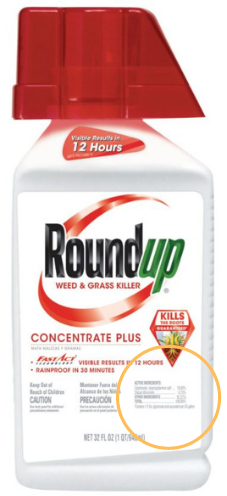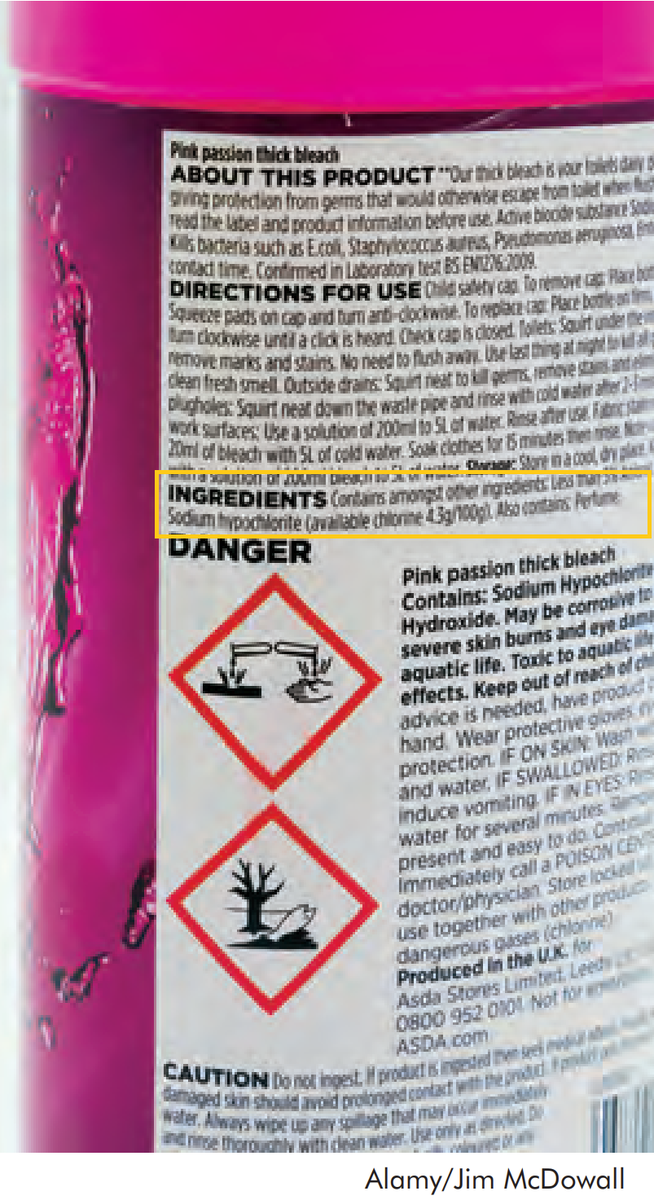Gateway on Pesticide Hazards and Safe Pest Management
How To Find Ingredients in Pesticide Products
Beyond Pesticides offers resources below to evaluate the health and ecological effects of specific chemical exposure from ACTIVE INGREDIENTS in pesticide products, as well as regulatory information and supporting scientific documents. Because various pesticide products can contain more than one active ingredient, it is important to READ the LABEL to determine chemical components.
With 192 different active ingredients and counting, it is essential to establish the connection between the use of these chemicals and their respective hazards.
View the step-by-step guide on how to search for the active ingredient(s) in pesticide products below:
- Go to U.S. EPA's Pesticide Product and Label System and enter the product name. The generic product name may vary.
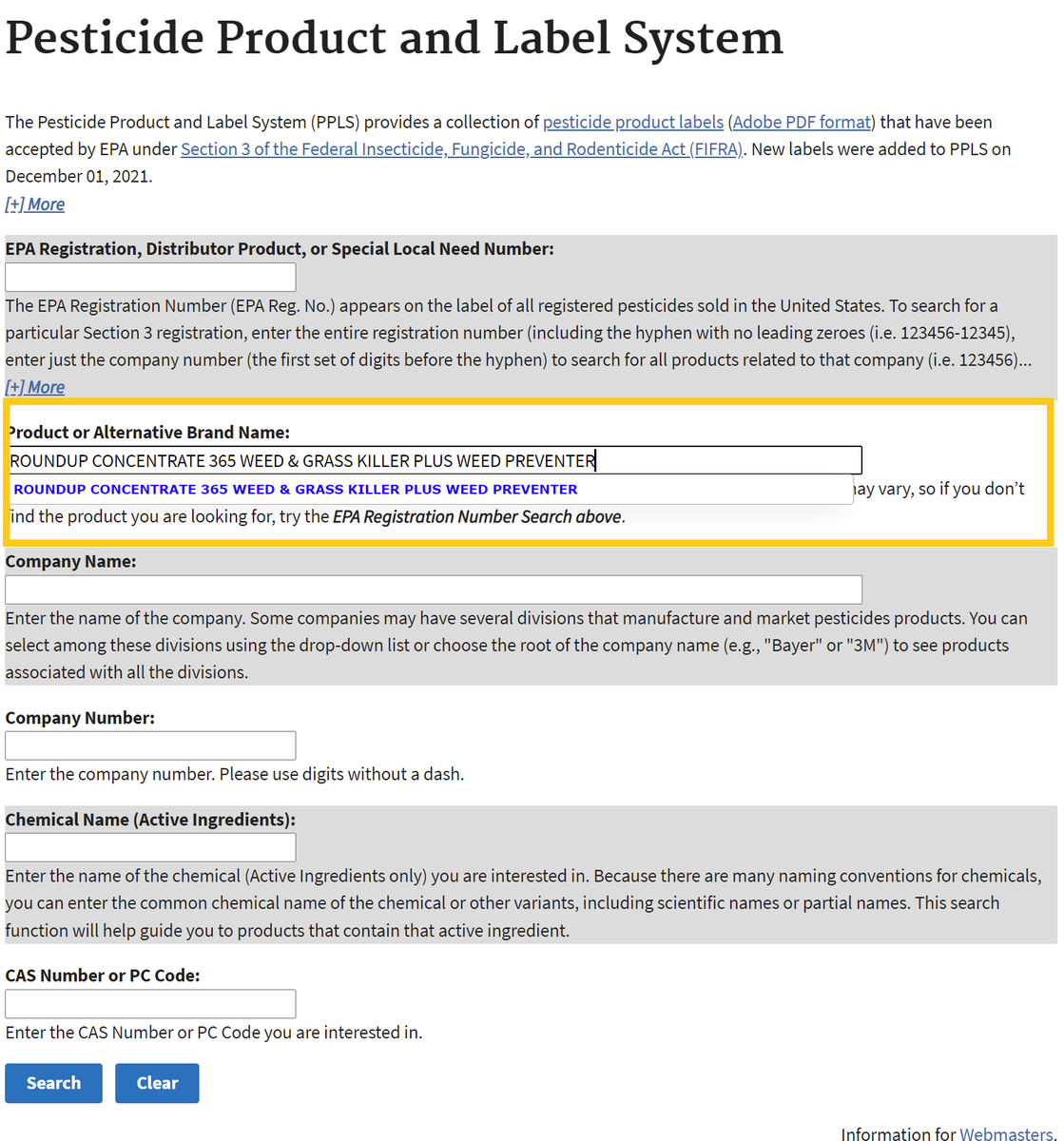
- After searching, click on the chemical ingredients tab or the link for the most recent label to find Active Ingredients.
Chemical List Label List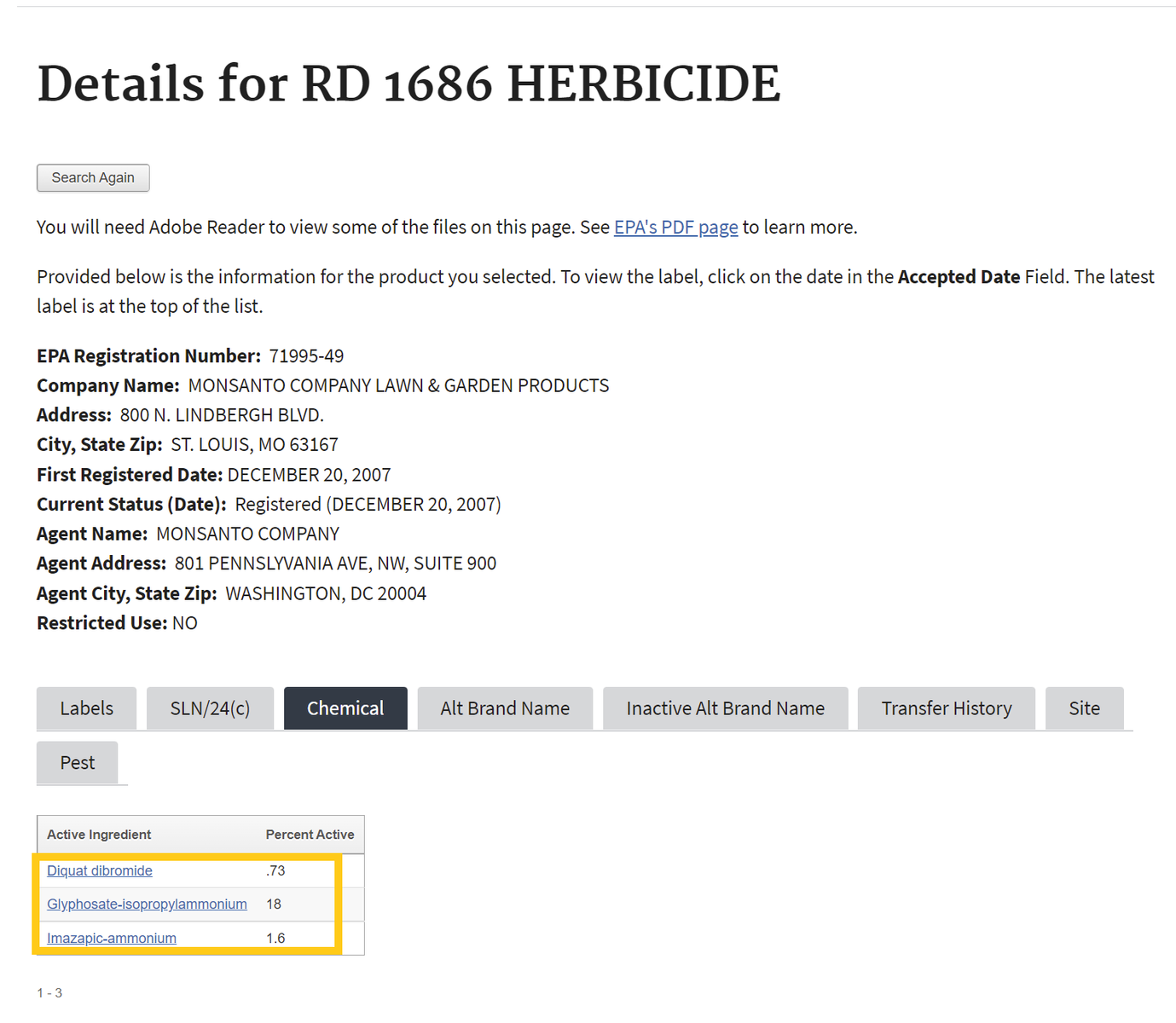
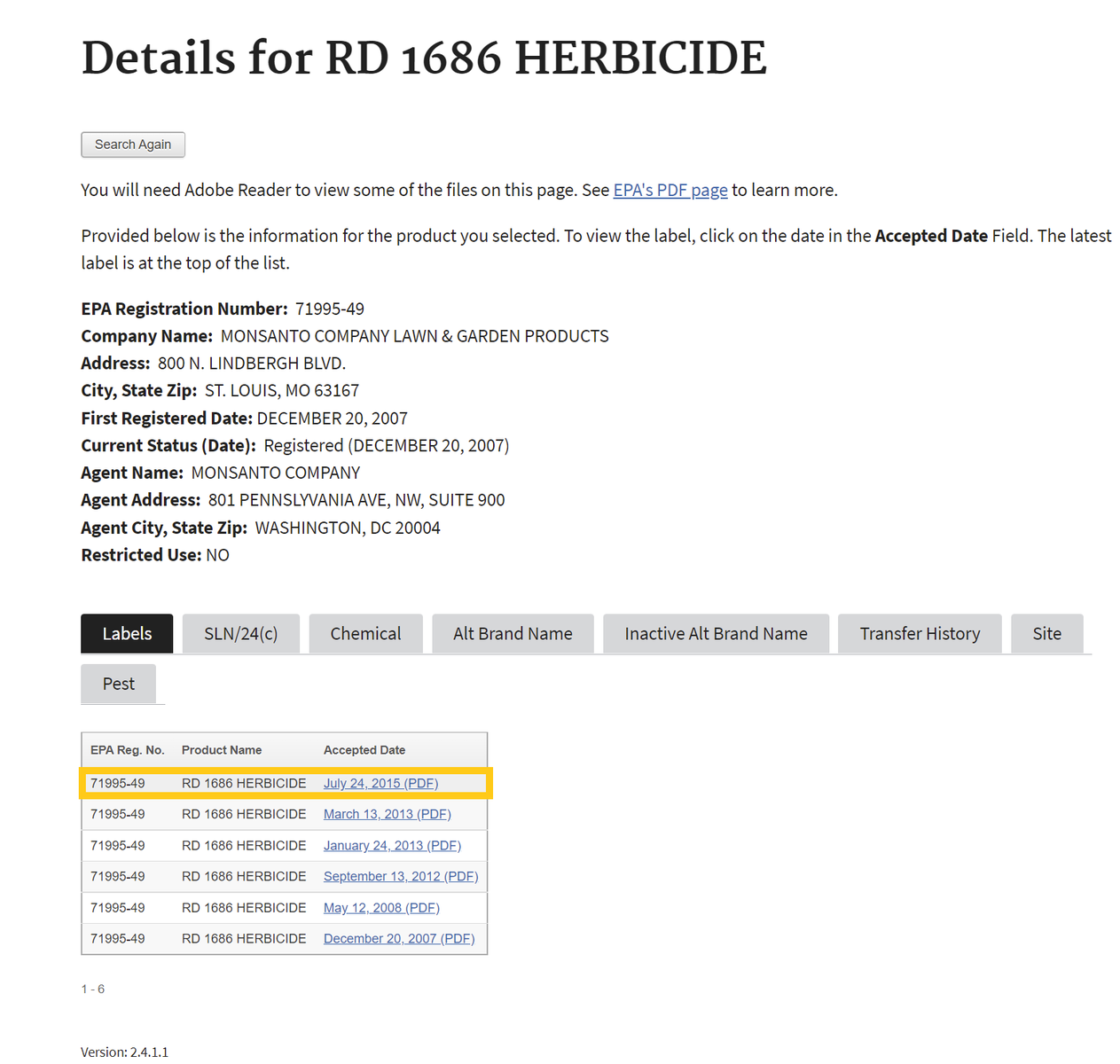
If one selects the chemical ingredients tab, skip to Step 4 . If not, proceed to step number 3 - To find the active ingredient(s) on the label, search for the page in the document containing the date of registration. Usually, the active ingredients section occurs within the first few pages of the label document.
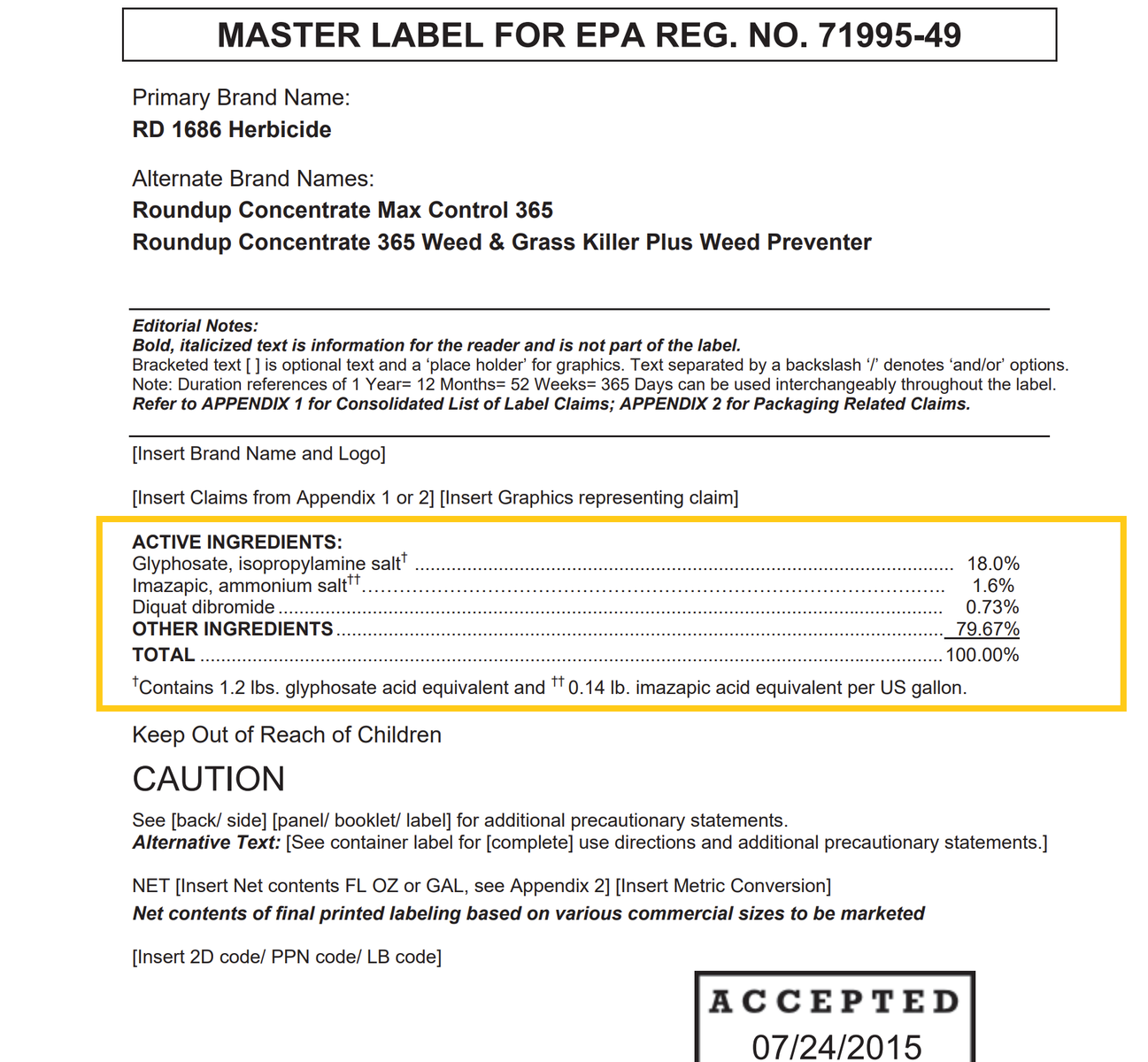
- Return to the Beyond Pesticides Gateway and search for the active ingredient name in the yellow box to the right or from the list below.
Dicamba
General Information
- Fact Sheet: Dicamba.pdf
- Product Names:
- Chemical Class: Benzoic acid herbicide
- Uses: Agricultural, industrial, and residential settings. Different forms of dicamba (acid and salts) have registered uses on rights-of-way areas, asparagus, barley, corn , grasses grown in pasture and rangeland, oats, proso millet, rye, sorghum, soybeans, sugarcane, and wheat, golf courses
and lawns. - Alternatives: Organic agriculture, Organic lawns care
- Beyond Pesticides rating: Toxic
Health and Environmental Effects
- Cancer: Suggestive (110, 182)
- Endocrine Disruption: Not documented
- Reproductive Effects: Yes (6)
- Neurotoxicity: Yes (6)
- Kidney/Liver Damage: Yes (4)
- Sensitizer/ Irritant: Yes (4)
- Birth/Developmental: Yes (11)
- Detected in Groundwater: Yes (6)
- Potential Leacher: Yes (7)
- Toxic to Birds: Yes (20, 40)
- Toxic to Fish/Aquatic Organisms: Yes (6)
- Toxic to Bees: Not documented
Residential Uses as Found in the ManageSafe™ Database
Additional Information
- Regulatory Status:
- Beyond Pesticides Comments (September 2025)
- Beyond Pesticides Comments (July 2024)
- Beyond Pesticides Comments (June 2024)
- Registration of Dicamba for Use on GE Crops
- Monsanto Petitions for Determinations of Nonregulated Status for Dicamba-Resistant Soybean and Cotton Varieties: Final Environmental Impact Statement (December 2014)
- EPA Reregistration Eligibility Decision (RED) signed (6/2006)
- Supporting information:
- Daily News Blog entries (Beyond Pesticides)
- Asthma, Children and Pesticides (Beyond Pesticides)
- NCAP Pesticide Factsheet (Northwest Coalition for Alternatives to Pesticides)
- PAN Pesticides Database:Dicamba (Pesticide Action Network)
- NPIC Dicamba Factsheet (National Pesticide Information Center)
- Studies:
- Dicamba drift affects non-target plants and pollinators (Penn State, 2015)
- Comparison of pesticide levels in carpet dust and self-reported pest treatment practices in four US sites. Colt, Joanne et. al.2004. Journal of Exposure Analysis and Environmental Epidemiology 14, 74–83.
- Do Pesticides Affect Learning Behavior? Porter, Warren. 2004. Pesticides and You (Beyond Pesticides).
- Dicamba use and cancer incidence in the agricultural health study: an updated analysis. Lerro, C.C., Hofmann, J.N., Andreotti, G., Koutros, S., Parks, C.G., Blair, A., Albert, P.S., Lubin, J.H., Sandler, D.P. and Beane Freeman, L.E., 2020. International Journal of Epidemiology.
- Cancer incidence among pesticide applicators exposed to dicamba in the Agricultural Health Study. Samanic, C., et al. 2006. Environ Health Perspect 114(10):1521-1526.
- Developmental Toxicity of a Commercial Herbicide Mixture in Mice: I. Effects on Embryo Implantation and Litter Size. Cavieres, M., et al. 2002. Environ Health Perspect 110:1081-1085
- Amine Volatilization from Herbicide Salts: Implications for Herbicide Formulations and Atmospheric Chemistry. Sharkey, S.M., Hartig, A.M., Dang, A.J., Chatterjee, A., Williams, B.J. and Parker, K.M., 2022. Environmental Science & Technology.
- Exposure to pesticides and risk of Hodgkin lymphoma in an international consortium of agricultural cohorts (AGRICOH). Kim, J., Leon, M.E., Schinasi, L.H., Baldi, I., Lebailly, P., Freeman, L.E.B., Nordby, K.C., Ferro, G., Monnereau, A., Brouwer, M. and Kjaerheim, K., 2023. Cancer Causes & Control, pp.1-9.
- Dicamba and 2,4-D in the Urine of Pregnant Women in the Midwest: Comparison of Two Cohorts (2010–2012 vs. 2020–2022). Daggy, J.K. et al. (2024) Dicamba and 2,4-D in the urine of pregnant women in the Midwest: Comparison of two cohorts (2010–2012 vs. 2020–2022), Agrochemicals. Available at: https://www.mdpi.com/2813-3145/3/1/5.
- Proximity to residential and workplace pesticides application and the risk of progression of Parkinson's diseases in Central California. Li, S. et al. (2022) Proximity to residential and workplace pesticides application and the risk of progression of parkinson’s diseases in Central California, Science of The Total Environment. Available at: https://www.sciencedirect.com/science/article/pii/S0048969722079542.
- Persistence of triclopyr, dicamba, and picloram in the environment following aerial spraying for control of dense pine invasion. Rolando, C.A. et al. (2023) Persistence of Triclopyr, dicamba, and Picloram in the environment following aerial spraying for control of dense pine invasion, Invasive Plant Science and Management. Available at: https://www.cambridge.org/core/journals/invasive-plant-science-and-management/article/persistence-of-triclopyr-dicamba-and-picloram-in-the-environment-following-aerial-spraying-for-control-of-dense-pine-invasion/EC888894C5B7A927AD5E5A3E0C06CD8D.
- Impact of Endocrine Disrupting Pesticide Use on Obesity: A Systematic Review. Pérez-Bermejo, M. et al. (2024) Impact of Endocrine Disrupting Pesticide Use on Obesity: A Systematic Review, Biomedicines. Available at: https://www.mdpi.com/2227-9059/12/12/2677.
- Beyond the field: How pesticide drift endangers biodiversity. Albaseer, S. et al. (2024) Beyond the field: How pesticide drift endangers biodiversity, Environmental Pollution. Available at: https://www.sciencedirect.com/science/article/pii/S0269749124022437.
- Response of Wine Grape Cultivars to Simulated Drift Rates of 2,4-D, Dicamba, and Glyphosate, and 2,4-D or Dicamba Plus Glyphosate. Mohseni-Moghadam, M. et al. (2017) Response of Wine Grape Cultivars to Simulated Drift Rates of 2,4-D, Dicamba, and Glyphosate, and 2,4-D or Dicamba Plus Glyphosate, Weed Technology. Available at: https://www.cambridge.org/core/journals/weed-technology/article/response-of-wine-grape-cultivars-to-simulated-drift-rates-of-24d-dicamba-and-glyphosate-and-24d-or-dicamba-plus-glyphosate/1BAD9A48DD98F8896E56C6823A2EE4A4.
- Genotoxicity evaluation of 2,4-D, dicamba and glyphosate alone or in combination with cell reporter assays for DNA damage, oxidative stress and unfolded protein response . Mesnage, R. et al. (2021) ‘Genotoxicity evaluation of 2,4-D, dicamba and glyphosate alone or in combination with cell reporter assays for DNA damage, oxidative stress and unfolded protein response’, Food and Chemical Toxicology, 157, p. 112601. doi:10.1016/j.fct.2021.112601.
- Toxic and histopathological effects induced by exposure to the pesticide dicamba in carp Cyprinus carpio L. Korkmaz, N. Toxic and histopathological effects induced by exposure to the pesticide dicamba in carp Cyprinus carpio L. Environ Sci Pollut Res 31, 65790–65803 (2024). https://doi.org/10.1007/s11356-024-35674-9
- Exploring the Joint Association Between Agrichemical Mixtures and Pediatric Cancer. Taiba, J. et al. (2025) Exploring the Joint Association Between Agrichemical Mixtures and Pediatric Cancer, GeoHealth. Available at: https://agupubs.onlinelibrary.wiley.com/doi/10.1029/2024GH001236.
- Off-target pesticide movement: a review of our current understanding of drift due to inversions and secondary movement. Bish M, Oseland E, Bradley K. Off-target pesticide movement: a review of our current understanding of drift due to inversions and secondary movement. Weed Technology. 2021;35(3):345-356. doi:10.1017/wet.2020.138
- Investigations of the Sensitivity of Ornamental, Fruit, and Nut Plant Species to Driftable Rates of 2,4-D and Dicamba. Dintelmann, Brian & Warmund, Michele & Bish, Mandy & Bradley, Kevin. (2019). Investigations of the Sensitivity of Ornamental, Fruit, and Nut Plant Species to Driftable Rates of 2,4-D and Dicamba. Weed Technology. 34. 1-35. 10.1017/wet.2019.118.
- Association between pesticide exposure and colorectal cancer risk and incidence: A systematic review. Matich, E. K., Laryea, J. A., Seely, K. A., Stahr, S., Su, L. J., & Hsu, P. C. (2021). Association between pesticide exposure and colorectal cancer risk and incidence: A systematic review. Ecotoxicology and environmental safety, 219, 112327. https://doi.org/10.1016/j.ecoenv.2021.112327








.png)
